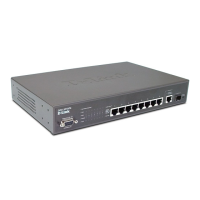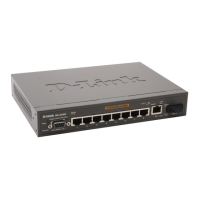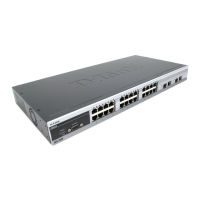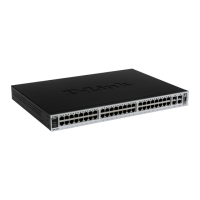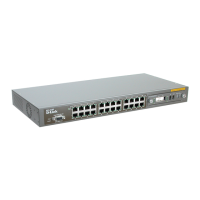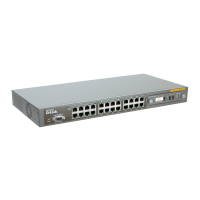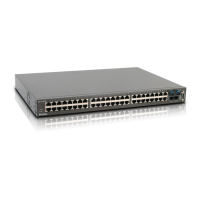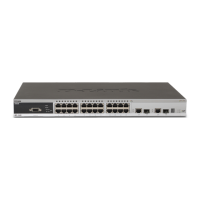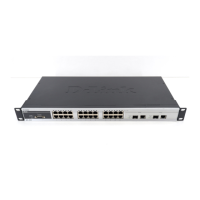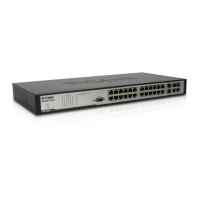
Do you have a question about the D-Link DES-3028 and is the answer not in the manual?
| Switching Capacity | 12.8 Gbps |
|---|---|
| Forwarding Rate | 9.5 Mpps |
| MAC Address Table Size | 8K entries |
| Jumbo Frame Support | Yes, up to 9KB |
| VLAN Support | Supports up to 255 VLANs |
| QoS | 802.1p Priority Queues |
| Management | Web-based GUI, SNMP, RMON |
| Dimensions | 440 x 44 mm |
| Weight | 3.2 kg |
| Standards | IEEE 802.3, 802.3u, 802.3ab, 802.3x, 802.1Q, 802.1p |
| Ports | 24 x 10/100 Mbps + 4 x 10/100/1000 Mbps |
Describes the switch and its features, including overview and key capabilities.
Covers package contents, connection guidelines, and rack mounting procedures.
Details how to connect the switch to end nodes, hubs, or other switches.
Overview of management options including console, web, and SNMP.
Covers accessing and using the switch's web interface for configuration.
Covers comprehensive configuration of switch functions like IP, ports, and services.
Details Layer 2 functionalities including VLAN, Trunking, IGMP, MLD, and Spanning Tree.
Explains Class of Service implementation, priority tagging, and scheduling mechanisms.
Covers Time Range, Access Profile Tables, and CPU Interface Filtering for packet control.
Details security functions like Traffic Control, Port Security, SSL, SSH, 802.1X, and DoS Prevention.
Covers monitoring CPU, port utilization, packets, errors, MAC addresses, and logs.
Provides detailed specifications for protocols, ports, performance, and environment.
Lists all possible system log entries and their meanings.
Explains ARP protocol, spoofing attacks, and countermeasures using Packet Content ACL.
Details the limited warranty terms for hardware and software.
Provides contact details for technical support in various regions.
Identifies the target audience for this manual.
Explains formatting conventions like bold, italics, and code text.
Defines the meaning of NOTE, NOTICE, and CAUTION symbols.
Provides essential safety guidelines for using the equipment.
Lists precautions to prevent injury, electrical shock, fire, or equipment damage.
Safety precautions specific to installing equipment in racks.
Steps to prevent damage to components from static electricity.
Details the DES-3028/28P/28G/52/52P switch family and its features.
Lists the main features and standards supported by the switch.
Details the types of ports available on different switch models.
Explains the status and meaning of all LED indicators on the switch.
Describes the components and layout of the switch's front panel.
Details the components and layout of the switch's rear panel.
Describes the side panels, including heat vents and fans.
Information on Gigabit Ethernet Combo ports and Mini-GBIC modules.
Instructions for installing SFP fiber-optic transceivers.
Lists all items included in the switch package.
Recommendations for selecting a suitable installation location.
Steps for installing the switch without a rack.
Instructions for mounting the switch in a standard 19-inch rack.
Procedures for AC power connection and handling power outages.
Describes methods for managing the switch: console, web, and SNMP.
Guide to accessing and using the web interface for configuration.
Information on managing the switch using SNMP versions 1, 2c, and 3.
Steps for connecting to the switch using the console port.
Steps for the first-time connection and login to the switch.
Securing the switch by setting up user accounts and passwords.
Details on configuring SNMP versions, traps, users, views, groups, and hosts.
How to assign and manage IP addresses for switch management.
Configuring individual port settings like speed, duplex, and flow control.
Creating, modifying, and deleting user accounts for switch access.
Testing the integrity and length of network cables connected to the switch.
Setting up port mirroring to monitor traffic on specific ports.
Configuring the switch to send log messages to designated Syslog servers.
Defining how log entries are triggered and managed.
Configuring Simple Network Time Protocol for accurate time settings.
Configuring time zones and Daylight Saving Time for SNTP.
Configuring notifications for MAC address learning events.
Setting up TFTP services for firmware and configuration file transfers.
Managing and configuring firmware images for the switch.
Using the ping utility to test network connectivity.
Protecting against DoS attacks and managing CPU utilization.
Configuring Power over Ethernet system settings and port assignments.
Concept and configuration of Single IP Management for stacked switches.
Viewing the network topology within the SIM group using Tree View.
Using mouse tooltips for viewing device information and connection speeds.
Functions available via right-clicking on devices in the topology view.
Steps for upgrading firmware from a Commander Switch to Member Switches.
Saving and retrieving switch configuration files via TFTP.
Uploading log files from member switches to a PC.
Configuring Unicast and Multicast forwarding and filtering modes.
Setting up email notifications for switch events via SMTP.
Explanation of Virtual LANs, segmentation, and 802.1Q tagging.
Configuring VLANs to allow devices to transmit/receive across different VLANs.
Creating and managing static VLAN entries with port assignments.
Configuring Generic VLAN Registration Protocol for dynamic VLAN sharing.
Setting up switch-to-switch links to carry traffic for multiple VLANs.
Enabling and configuring QinQ for service providers carrying customer traffic.
Combining multiple ports into a single high-bandwidth data pipeline.
Configuring Link Aggregation Control Protocol port trunking.
Managing IGMP snooping settings for efficient multicast traffic forwarding.
Configuring ports to act as static router ports for multicast traffic.
Providing client-server authentication for IP multicast group access.
Configuring settings for dynamic IP multicast learning.
Configuring Multicast VLANs to reduce traffic load.
Adding profiles to filter multicast address reports on specified ports.
Configuring ports involved in Limited IP Multicast Range.
Configuring ports for maximum filter group up to 256.
Managing MLD snooping settings for IPv6 multicast traffic.
Designating ports connected to multicast-enabled routers.
Introduction to STP, RSTP, and MSTP protocols for network fault tolerance.
Configuring STP to prevent and detect loop conditions.
Configuring global STP parameters like bridge age, hello time, and STP version.
Configuring STP parameters on a per-port basis.
Configuring MSTI instances for Multiple Spanning Tree Protocol.
Viewing and managing currently configured MST instances.
Detecting and preventing port loops using CTP packets.
Configuring Link Layer Discovery Protocol for network topology information.
Setting up LLDP on individual ports for neighbor discovery.
Configuring 802.1 extension LLDP on switch ports.
Configuring 802.3 extension LLDP on switch ports.
Setting up LLDP management address configurations on the switch.
Viewing LLDP statistics for network discovery information.
Viewing and managing LLDP management address entries.
Displaying brief information about LLDP local ports.
Displaying brief information about LLDP remote ports.
Explains priority tagging for managing network traffic delivery.
Benefits of implementing CoS for bandwidth management and traffic prioritization.
Setting ceilings on transmitting and receiving data rates for selected ports.
Assigning a default 802.1p priority to each port on the switch.
Assigning a class of service to each of the 802.1p priorities.
Choosing between Weight Fair and Strict mechanisms for priority class handling.
Customizing output scheduling for hardware classes of service.
Configuring CoS priority settings on a port-by-port basis.
Classifying packets based on the TOS field in the IP header.
Classifying packets based on the DSCP field in the IP header.
Assigning port-based priority to egress queues.
Classifying packets based on MAC address field priority.
Setting specific time periods for Access Profile activation.
Establishing criteria for packet forwarding based on packet header information.
Creating rules to filter packets destined for the switch's CPU interface.
Managing broadcast, multicast, and unicast storm control settings.
Preventing unauthorized access by locking MAC addresses to specific ports.
Managing permanently learned MAC addresses for port security.
Restricting network access based on IP-MAC-Port binding entries.
Configuring Secure Sockets Layer for secure communication.
Setting up Secure Shell server for secure remote login and services.
Configuring SSH authentication modes and encryption algorithms.
Configuring user authentication methods for SSH access.
Implementing Port-Based and Host-Based Access Control using 802.1X.
Setting up Guest VLANs for limited access for non-802.1X devices.
Initializing ports for Port-Based and Host-Based 802.1X.
Reauthenticating ports for Port-Based and Host-Based 802.1X.
Configuring RADIUS server settings for authentication and accounting.
Using TACACS/RADIUS protocols for user authentication and access control.
Defining authentication policies and response timeouts.
Configuring authentication for console, Telnet, SSH, and web applications.
Grouping authentication server hosts by protocol for method lists.
Setting up user-defined authentication server hosts.
Creating sequences of authentication techniques for user logins.
Setting up lists to promote users to Administrator level privileges.
Configuring the locally enabled password for the Enable Admin command.
Promoting a user from normal to administrator level privileges.
Limiting traffic flow between ports or VLANs for network segmentation.
Protecting the network against various Denial of Service attacks.
Displaying the percentage of CPU usage over time.
Displaying the percentage of available bandwidth used on each port.
Analyzing received packet data graphically and in table format.
Analyzing received UMB cast packets graphically and in table format.
Analyzing transmitted packet data graphically and in table format.
Displaying received packet error statistics graphically and in table format.
Displaying transmitted packet error statistics graphically and in table format.
Analyzing received packet size distribution graphically and in table format.
Viewing the switch's dynamic MAC address forwarding table.
Viewing the switch's recorded event history log.
Viewing IGMP snooping group table to monitor multicast traffic.
Displaying ports configured as static or dynamic router ports.
Viewing the VLAN status for each port (Egress or Tag).
Viewing MLD Snooping Groups present on the switch.
Viewing and managing static ARP entries on the switch.
Viewing current ARP-FDB entries and adding to IP-MAC-Port Binding Table.
Configuring settings for gratuitous ARP packets and IP conflict detection.
Viewing detailed information on current configuration sessions.
Monitoring 802.1X statistics on a per-port basis.
Information on RADIUS authentication client activity.
Statistics associated with RADIUS accounting clients.
Options for resetting the switch configuration to factory defaults.
Restarting the switch and options for saving current configuration.
Exiting the switch management session.
Detailed specifications including protocols, ports, and performance metrics.
Information on Power over Ethernet capabilities and standards.
Guide to understanding the status and meaning of switch LEDs.
Table detailing maximum cable lengths for various standards.
Steps to reset forgotten or destroyed passwords on D-Link switches.
Definitions of common networking terms and acronyms used in the manual.
Details on ARP protocol, spoofing attacks, and ACL countermeasures.
Safety warnings for handling laser optic modules and fiber connections.
Information regarding voluntary product registration.


